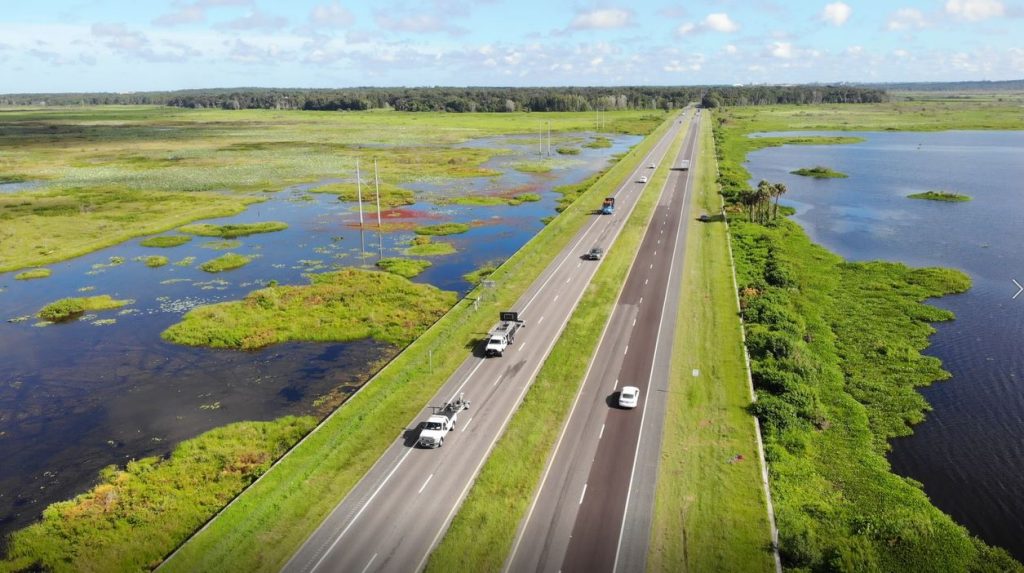
The many thousands of miles of roadways in Florida require periodic maintenance in the form of striping, widening, adding bicycle lanes, filling potholes, and many other operations to keep roads in their best drivable condition. These operations require the efforts of thousands of workers across the state who often work next to traffic that is traveling at 40–70 miles per hour. The literature reveals that one has less than a 50% chance of surviving an impact at 30 mph and almost no chance of surviving an impact at 50 mph[1]. All transportation agencies in Florida have standards for establishing safe work zones, including “Workers Ahead” signs, cones, lighted arrows, etc. The goal is to protect workers from the traffic that is moving next to, or around, the work zone.
Sometimes, the work zone itself is moving (mobile work zones), for example, when a road is being striped or roadway testing is being conducted. In that case, the truck carrying workers and equipment is protected by another truck that follows a few hundred feet behind with a crash barrier (attenuator). These trucks are moving at 5–15 miles per hour, much slower than regular traffic. The follower truck acts as a shield. It also carries an advance warning lighted arrow sign to warn drivers hundreds of yards away that they are approaching a slower moving vehicle and must use extra caution and change lanes.
Nevertheless, cars traveling at the prevailing speed crash into the follower vehicle. In anticipation of these events, the follower vehicle is equipped with an attenuator, a device that extends from the back of the truck and is designed to absorb the impact of a collision at highway speeds. Even then, the force of a collision at high speeds or with larger vehicles can result in injury or death of the driver of the follower vehicle.
The UFTI-T2 Center has recently concluded testing of a new technology that improves safety for the driver of a follower vehicle by removing the driver altogether. This technology, called an autonomous truck-mounted attenuator (ATMA), uses advanced object detection and communications that allow the follower vehicle to follow a lead vehicle without a driver. UFTI-T2 researchers’ objective was to find out if this potentially life-saving technology would work on Florida roadways and under what environmental conditions and facility types.
The ATMA used in these tests is manufactured by Kratos Defense and Security Solutions, Inc., a company headquartered in San Diego, CA, and with offices in Orlando, FL, a center for defense contractor work in the state. UFTI-T2 rented a follower truck that was fully equipped with an attenuator and autonomous guidance technology for the tests. A standard truck used by the Florida Department of Transportation was loaned to UFTI-T2 and delivered to Kratos to be retrofitted as a leader vehicle.
Several testing sites were selected that would provide a range of Florida roadway types. Initial tests, demonstrations, and training took place at a non-roadway location so that all personnel involved in the research could examine and use the equipment in a safe environment before roadway testing. Kratos personnel delivered the leader and follower vehicles to the demonstration site and trained personnel participating in the research. Kratos trainers gave research personnel a thorough tour of both vehicles, outside and inside, to review the technology and demonstrate the setup and operation of the ATMA.
In a series of demonstration runs, Kratos personnel drove both the leader and follower trucks. For all demonstration and research runs, a driver remained in the follower vehicle, even when it was in autonomous mode, to provide an extra margin of safety. Research personnel and students from the UFTI were invited to ride along in both vehicles to learn the operational procedures and experience the autonomous operation.
A battery of tests were conducted in the demonstration location, including the automated stopping function, the emergency stop feature, accuracy of following in terms of both distance and path, lane-changing, vehicle intruding between leader and follower, object recognition, and many others.
The next step after a demonstration and training phase was to take the ATMA out on the open road. Six test sites were selected that represented a range of Florida highways types:
- Multilane, semi-urban high-speed environment with moderate traffic
- Limited access, multilane, urban high-speed freeway with high traffic volume
- Multilane, high traffic, low-speed urban environment with three signalized intersections and multiple access points on corridors
- High speed, rural, two-lane roadway with high traffic volume
- Low speed, urban, two-lane roadway with low traffic
- High speed, semi-urban, multi-lane roadway with moderate traffic.
Data were collected from the ATMA system and field observations, and video was recorded. Data analysis is underway and the team will report preliminary results to the stakeholders in the next few weeks. Stay tuned for updates and findings from this project in the next newsletter!
The multilane, high traffic site was used for tests at night. All other sites were used during daylight hours. During the tests, the leader vehicle pulled a trailer carrying a falling weight deflectometer (FWD), used to evaluate the soundness of pavement. The FWD is used to test stretches of roadway during occasional stops between which the leader vehicle moves at a few miles per hour.
[1] WHO Road Safety Fact Sheet (return to text)
(Return to top) (Return to UFTI-T2 October 2020 Newsletter)